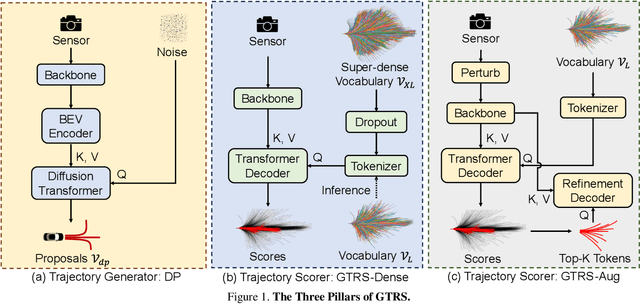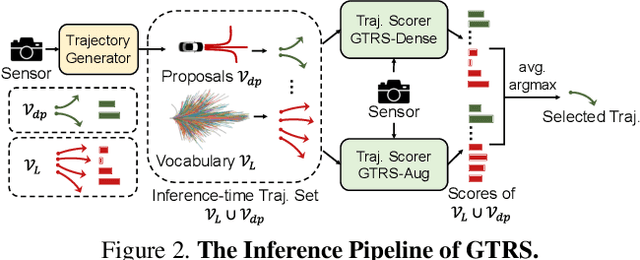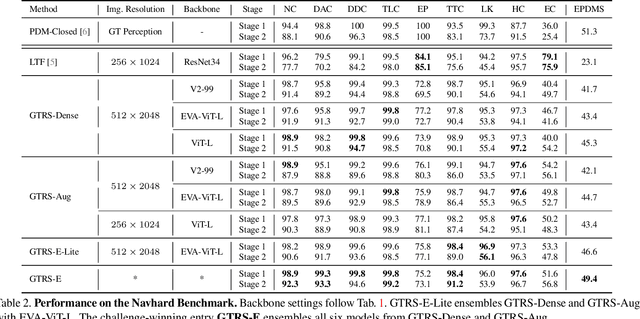Zuxuan Wu
Ask-to-Clarify: Resolving Instruction Ambiguity through Multi-turn Dialogue
Sep 18, 2025Abstract:The ultimate goal of embodied agents is to create collaborators that can interact with humans, not mere executors that passively follow instructions. This requires agents to communicate, coordinate, and adapt their actions based on human feedback. Recently, advances in VLAs have offered a path toward this goal. However, most current VLA-based embodied agents operate in a one-way mode: they receive an instruction and execute it without feedback. This approach fails in real-world scenarios where instructions are often ambiguous. In this paper, we address this problem with the Ask-to-Clarify framework. Our framework first resolves ambiguous instructions by asking questions in a multi-turn dialogue. Then it generates low-level actions end-to-end. Specifically, the Ask-to-Clarify framework consists of two components, one VLM for collaboration and one diffusion for action. We also introduce a connection module that generates conditions for the diffusion based on the output of the VLM. This module adjusts the observation by instructions to create reliable conditions. We train our framework with a two-stage knowledge-insulation strategy. First, we fine-tune the collaboration component using ambiguity-solving dialogue data to handle ambiguity. Then, we integrate the action component while freezing the collaboration one. This preserves the interaction abilities while fine-tuning the diffusion to generate actions. The training strategy guarantees our framework can first ask questions, then generate actions. During inference, a signal detector functions as a router that helps our framework switch between asking questions and taking actions. We evaluate the Ask-to-Clarify framework in 8 real-world tasks, where it outperforms existing state-of-the-art VLAs. The results suggest that our proposed framework, along with the training strategy, provides a path toward collaborative embodied agents.
AgentGym-RL: Training LLM Agents for Long-Horizon Decision Making through Multi-Turn Reinforcement Learning
Sep 10, 2025Abstract:Developing autonomous LLM agents capable of making a series of intelligent decisions to solve complex, real-world tasks is a fast-evolving frontier. Like human cognitive development, agents are expected to acquire knowledge and skills through exploration and interaction with the environment. Despite advances, the community still lacks a unified, interactive reinforcement learning (RL) framework that can effectively train such agents from scratch -- without relying on supervised fine-tuning (SFT) -- across diverse and realistic environments. To bridge this gap, we introduce AgentGym-RL, a new framework to train LLM agents for multi-turn interactive decision-making through RL. The framework features a modular and decoupled architecture, ensuring high flexibility and extensibility. It encompasses a wide variety of real-world scenarios, and supports mainstream RL algorithms. Furthermore, we propose ScalingInter-RL, a training approach designed for exploration-exploitation balance and stable RL optimization. In early stages, it emphasizes exploitation by restricting the number of interactions, and gradually shifts towards exploration with larger horizons to encourage diverse problem-solving strategies. In this way, the agent develops more diverse behaviors and is less prone to collapse under long horizons. We perform extensive experiments to validate the stability and effectiveness of both the AgentGym-RL framework and the ScalingInter-RL approach. Our agents match or surpass commercial models on 27 tasks across diverse environments. We offer key insights and will open-source the complete AgentGym-RL framework -- including code and datasets -- to empower the research community in developing the next generation of intelligent agents.
Repeating Words for Video-Language Retrieval with Coarse-to-Fine Objectives
Aug 20, 2025Abstract:The explosive growth of video streaming presents challenges in achieving high accuracy and low training costs for video-language retrieval. However, existing methods rely on large-scale pre-training to improve video retrieval performance, resulting in significant computational demands. Additionally, the fine-grained information in videos and texts remains underexplored. To alleviate these problems, we propose a novel framework to learn fine-grained features for better alignment and introduce an inference pipeline to improve performance without additional training. Specifically, we employ coarse-to-fine objectives to understand the semantic information of video-text pairs, including contrastive and matching learning. The fine-grained data used for training is obtained through the Granularity-Aware Representation module, which is designed based on similarity analysis between video frames and words in captions. Furthermore, we observe that the repetition of keywords in the original captions, referred to as "Repetition", can enhance retrieval performance and improve alignment between video and text. Based on this insight, we propose a novel and effective inference pipeline that incorporates a voting mechanism and a new Matching Entropy metric to achieve better retrieval performance without requiring additional pre-training. Experimental results on four benchmarks demonstrate that the proposed method outperforms previous approaches. Additionally, our inference pipeline achieves significant performance improvements, with a 2.1% increase in Recall@1 on the MSR-VTT dataset and a 1.6% increase on the DiDeMo dataset.
StableAvatar: Infinite-Length Audio-Driven Avatar Video Generation
Aug 11, 2025Abstract:Current diffusion models for audio-driven avatar video generation struggle to synthesize long videos with natural audio synchronization and identity consistency. This paper presents StableAvatar, the first end-to-end video diffusion transformer that synthesizes infinite-length high-quality videos without post-processing. Conditioned on a reference image and audio, StableAvatar integrates tailored training and inference modules to enable infinite-length video generation. We observe that the main reason preventing existing models from generating long videos lies in their audio modeling. They typically rely on third-party off-the-shelf extractors to obtain audio embeddings, which are then directly injected into the diffusion model via cross-attention. Since current diffusion backbones lack any audio-related priors, this approach causes severe latent distribution error accumulation across video clips, leading the latent distribution of subsequent segments to drift away from the optimal distribution gradually. To address this, StableAvatar introduces a novel Time-step-aware Audio Adapter that prevents error accumulation via time-step-aware modulation. During inference, we propose a novel Audio Native Guidance Mechanism to further enhance the audio synchronization by leveraging the diffusion's own evolving joint audio-latent prediction as a dynamic guidance signal. To enhance the smoothness of the infinite-length videos, we introduce a Dynamic Weighted Sliding-window Strategy that fuses latent over time. Experiments on benchmarks show the effectiveness of StableAvatar both qualitatively and quantitatively.
Multimodal Referring Segmentation: A Survey
Aug 01, 2025Abstract:Multimodal referring segmentation aims to segment target objects in visual scenes, such as images, videos, and 3D scenes, based on referring expressions in text or audio format. This task plays a crucial role in practical applications requiring accurate object perception based on user instructions. Over the past decade, it has gained significant attention in the multimodal community, driven by advances in convolutional neural networks, transformers, and large language models, all of which have substantially improved multimodal perception capabilities. This paper provides a comprehensive survey of multimodal referring segmentation. We begin by introducing this field's background, including problem definitions and commonly used datasets. Next, we summarize a unified meta architecture for referring segmentation and review representative methods across three primary visual scenes, including images, videos, and 3D scenes. We further discuss Generalized Referring Expression (GREx) methods to address the challenges of real-world complexity, along with related tasks and practical applications. Extensive performance comparisons on standard benchmarks are also provided. We continually track related works at https://github.com/henghuiding/Awesome-Multimodal-Referring-Segmentation.
Rethinking Discrete Tokens: Treating Them as Conditions for Continuous Autoregressive Image Synthesis
Jul 02, 2025Abstract:Recent advances in large language models (LLMs) have spurred interests in encoding images as discrete tokens and leveraging autoregressive (AR) frameworks for visual generation. However, the quantization process in AR-based visual generation models inherently introduces information loss that degrades image fidelity. To mitigate this limitation, recent studies have explored to autoregressively predict continuous tokens. Unlike discrete tokens that reside in a structured and bounded space, continuous representations exist in an unbounded, high-dimensional space, making density estimation more challenging and increasing the risk of generating out-of-distribution artifacts. Based on the above findings, this work introduces DisCon (Discrete-Conditioned Continuous Autoregressive Model), a novel framework that reinterprets discrete tokens as conditional signals rather than generation targets. By modeling the conditional probability of continuous representations conditioned on discrete tokens, DisCon circumvents the optimization challenges of continuous token modeling while avoiding the information loss caused by quantization. DisCon achieves a gFID score of 1.38 on ImageNet 256$\times$256 generation, outperforming state-of-the-art autoregressive approaches by a clear margin.
FreeLoRA: Enabling Training-Free LoRA Fusion for Autoregressive Multi-Subject Personalization
Jul 02, 2025Abstract:Subject-driven image generation plays a crucial role in applications such as virtual try-on and poster design. Existing approaches typically fine-tune pretrained generative models or apply LoRA-based adaptations for individual subjects. However, these methods struggle with multi-subject personalization, as combining independently adapted modules often requires complex re-tuning or joint optimization. We present FreeLoRA, a simple and generalizable framework that enables training-free fusion of subject-specific LoRA modules for multi-subject personalization. Each LoRA module is adapted on a few images of a specific subject using a Full Token Tuning strategy, where it is applied across all tokens in the prompt to encourage weakly supervised token-content alignment. At inference, we adopt Subject-Aware Inference, activating each module only on its corresponding subject tokens. This enables training-free fusion of multiple personalized subjects within a single image, while mitigating overfitting and mutual interference between subjects. Extensive experiments show that FreeLoRA achieves strong performance in both subject fidelity and prompt consistency.
DriveSuprim: Towards Precise Trajectory Selection for End-to-End Planning
Jun 07, 2025Abstract:In complex driving environments, autonomous vehicles must navigate safely. Relying on a single predicted path, as in regression-based approaches, usually does not explicitly assess the safety of the predicted trajectory. Selection-based methods address this by generating and scoring multiple trajectory candidates and predicting the safety score for each, but face optimization challenges in precisely selecting the best option from thousands of possibilities and distinguishing subtle but safety-critical differences, especially in rare or underrepresented scenarios. We propose DriveSuprim to overcome these challenges and advance the selection-based paradigm through a coarse-to-fine paradigm for progressive candidate filtering, a rotation-based augmentation method to improve robustness in out-of-distribution scenarios, and a self-distillation framework to stabilize training. DriveSuprim achieves state-of-the-art performance, reaching 93.5% PDMS in NAVSIM v1 and 87.1% EPDMS in NAVSIM v2 without extra data, demonstrating superior safetycritical capabilities, including collision avoidance and compliance with rules, while maintaining high trajectory quality in various driving scenarios.
Generalized Trajectory Scoring for End-to-end Multimodal Planning
Jun 07, 2025



Abstract:End-to-end multi-modal planning is a promising paradigm in autonomous driving, enabling decision-making with diverse trajectory candidates. A key component is a robust trajectory scorer capable of selecting the optimal trajectory from these candidates. While recent trajectory scorers focus on scoring either large sets of static trajectories or small sets of dynamically generated ones, both approaches face significant limitations in generalization. Static vocabularies provide effective coarse discretization but struggle to make fine-grained adaptation, while dynamic proposals offer detailed precision but fail to capture broader trajectory distributions. To overcome these challenges, we propose GTRS (Generalized Trajectory Scoring), a unified framework for end-to-end multi-modal planning that combines coarse and fine-grained trajectory evaluation. GTRS consists of three complementary innovations: (1) a diffusion-based trajectory generator that produces diverse fine-grained proposals; (2) a vocabulary generalization technique that trains a scorer on super-dense trajectory sets with dropout regularization, enabling its robust inference on smaller subsets; and (3) a sensor augmentation strategy that enhances out-of-domain generalization while incorporating refinement training for critical trajectory discrimination. As the winning solution of the Navsim v2 Challenge, GTRS demonstrates superior performance even with sub-optimal sensor inputs, approaching privileged methods that rely on ground-truth perception. Code will be available at https://github.com/NVlabs/GTRS.
CreatiDesign: A Unified Multi-Conditional Diffusion Transformer for Creative Graphic Design
May 25, 2025Abstract:Graphic design plays a vital role in visual communication across advertising, marketing, and multimedia entertainment. Prior work has explored automated graphic design generation using diffusion models, aiming to streamline creative workflows and democratize design capabilities. However, complex graphic design scenarios require accurately adhering to design intent specified by multiple heterogeneous user-provided elements (\eg images, layouts, and texts), which pose multi-condition control challenges for existing methods. Specifically, previous single-condition control models demonstrate effectiveness only within their specialized domains but fail to generalize to other conditions, while existing multi-condition methods often lack fine-grained control over each sub-condition and compromise overall compositional harmony. To address these limitations, we introduce CreatiDesign, a systematic solution for automated graphic design covering both model architecture and dataset construction. First, we design a unified multi-condition driven architecture that enables flexible and precise integration of heterogeneous design elements with minimal architectural modifications to the base diffusion model. Furthermore, to ensure that each condition precisely controls its designated image region and to avoid interference between conditions, we propose a multimodal attention mask mechanism. Additionally, we develop a fully automated pipeline for constructing graphic design datasets, and introduce a new dataset with 400K samples featuring multi-condition annotations, along with a comprehensive benchmark. Experimental results show that CreatiDesign outperforms existing models by a clear margin in faithfully adhering to user intent.
 Add to Chrome
Add to Chrome Add to Firefox
Add to Firefox Add to Edge
Add to Edge